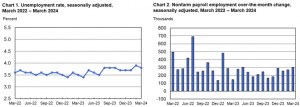April 5, 2024
According to the U.S. Bureau of Labor Statistics, total nonfarm payroll employment experienced an increase of 303,000 in March, while the unemployment rate remained relatively stable at 3.8 percent. Noteworthy job gains were observed particularly in sectors such as health care, government, and construction. The U.S. Bureau of Labor Statistics reported these findings based on two monthly surveys: the household survey, which assesses labor force status, including unemployment by demographic characteristics, and the establishment survey, which measures nonfarm employment, hours, and earnings by industry.

Household Survey Data
In March, the U.S. labour market displayed stability, with the unemployment rate holding steady at 3.8 percent, and the number of unemployed individuals remaining at 6.4 million. These figures have remained within a narrow range since August 2023. Among various demographic groups, the unemployment rate for Blacks increased, while it decreased for Asians and Hispanics. However, rates for adult men, adult women, teenagers, and Whites saw minimal fluctuations. The number of long-term unemployed remained relatively unchanged, accounting for about 19.5 percent of the total unemployed population. Additionally, key metrics such as the labour force participation rate and the employment-population ratio showed little variation both over the month and compared to the previous year, indicating overall steadiness in the labour market.
In March, the number of individuals employed part-time for economic reasons remained relatively stable at 4.3 million, indicating little change in their situation of desiring full-time employment but working fewer hours or unable to secure full-time jobs. Additionally, the number of people not in the labour force but seeking employment saw minimal fluctuation, with 5.4 million individuals expressing a desire for a job but not actively looking for work. Among this group, the number of marginally attached individuals, who were available and seeking work but hadn’t actively searched in the past month, remained unchanged at 1.6 million, with 337,000 of them being discouraged workers who believed no jobs were available for them.
Establishment Survey Data
In March, total nonfarm payroll employment in the United States surged by 303,000, surpassing the average monthly gain of 231,000 observed over the past year. Notably, job growth was prominent in key sectors such as health care, government, and construction. Health care saw an addition of 72,000 jobs, with notable gains in ambulatory health care services, hospitals, and nursing and residential care facilities. Government employment rose by 71,000, primarily driven by increases in local and federal government positions. Construction added 39,000 jobs, double the average monthly gain, largely attributed to growth in non-residential specialty trade contractors. Sectors such as leisure and hospitality, other services, and social assistance also experienced employment increases. However, industries like retail trade saw minimal change in employment, with some subsectors reporting gains offset by losses. Overall, employment remained relatively stable in other major industries.
In March, there was a notable increase in average hourly earnings for all employees on private nonfarm payrolls, rising by 12 cents or 0.3 percent to $34.69. Over the past year, there has been a significant uptick of 4.1 percent in average hourly earnings. Similarly, average hourly earnings for private-sector production and nonsupervisory employees also saw a modest increase, rising by 7 cents or 0.2 percent to $29.79. Additionally, the average workweek for all employees on private nonfarm payrolls edged up slightly by 0.1 hour to 34.4 hours, while manufacturing saw no change in the average workweek, remaining at 40.0 hours. Overtime in manufacturing decreased slightly by 0.1 hour to 2.9 hours. The average workweek for production and nonsupervisory employees on private nonfarm payrolls increased by 0.1 hour to 33.9 hours.
Revisions to the nonfarm payroll employment data for January and February were reported, with January’s figures adjusted upward by 27,000, now totalling a gain of 256,000 jobs, while February’s numbers were revised downward by 5,000, resulting in a total of 270,000 jobs added. These adjustments culminate in a combined increase of 22,000 jobs from the previously reported data for both months. These revisions are typical and reflect additional reports received from businesses and government agencies since the last published estimates, as well as recalculations of seasonal factors.
Disclaimer:
Analyst Certification – The views expressed in this research report accurately reflect the personal views of Mayberry Investments Limited Research Department about those issuer (s) or securities as at the date of this report. Each research analyst (s) also certify that no part of their compensation was, is, or will be, directly or indirectly, related to the specific recommendation(s) or view (s) expressed by that research analyst in this research report.
Company Disclosure – The information contained herein has been obtained from sources believed to be reliable, however its accuracy and completeness cannot be guaranteed. You are hereby notified that any disclosure, copying, distribution or taking any action in reliance on the contents of this information is strictly prohibited and may be unlawful. Mayberry may effect transactions or have positions in securities mentioned herein. In addition, employees of Mayberry may have positions and effect transactions in the securities mentioned herein.
